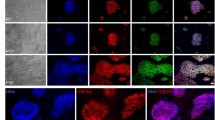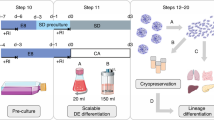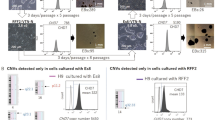Abstract
In order to promote the uniform and reproducible differentiation of human embryonic stem cells (HESCs) in response to exogenously added growth factors, we have developed a method (spin embryoid bodies (EBs)) that uses a recombinant protein-based, animal product-free medium in which HESCs are aggregated by centrifugation to form EBs. In this protocol we describe the formulation of this medium, denoted APEL (Albumin Polyvinylalcohol Essential Lipids), and its use in spin EB differentiation of HESCs. We also describe a more economical variant, BPEL (Bovine Serum Albumin (BSA) Polyvinylalchohol Essential Lipids), in which BSA replaces the recombinant human albumin. The integration of a medium that includes only defined and recombinant components with a defined number of cells to initiate EB formation results in a generally applicable, robust platform for growth factor-directed HESC differentiation.
This is a preview of subscription content, access via your institution
Access options
Subscribe to this journal
Receive 12 print issues and online access
$259.00 per year
only $21.58 per issue
Buy this article
- Purchase on Springer Link
- Instant access to full article PDF
Prices may be subject to local taxes which are calculated during checkout




Similar content being viewed by others
References
Schuldiner, M., Yanuka, O., Itskovitz-Eldor, J., Melton, D.A. & Benvenisty, N. Effects of eight growth factors on the differentiation of cells derived from human embryonic stem cells. Proc. Natl. Acad. Sci. USA 97, 11307–11312 (2000).
Chadwick, K. et al. Cytokines and BMP-4 promote hematopoietic differentiation of human embryonic stem cells. Blood 102, 906–915 (2003).
D'Amour, K.A. et al. Efficient differentiation of human embryonic stem cells to definitive endoderm. Nat. Biotechnol. 23, 1534–1541 (2005).
Jiang, W. et al. In vitro derivation of functional insulin-producing cells from human embryonic stem cells. Cell Res. 17, 333–344 (2007).
Kaufman, D.S., Hanson, E.T., Lewis, R.L., Auerbach, R. & Thomson, J.A. Hematopoietic colony-forming cells derived from human embryonic stem cells. Proc. Natl. Acad. Sci. USA 98, 10716–10721 (2001).
Vodyanik, M.A., Bork, J.A. & Thomson, J.A. Slukvin, II Human embryonic stem cell-derived CD34. cells: efficient production in the coculture with OP9 stromal cells and analysis of lymphohematopoietic potential. Blood 105, 617–626 (2005).
Kennedy, M., D'Souza, S.L., Lynch-Kattman, M., Schwantz, S. & Keller, G. Development of the hemangioblast defines the onset of hematopoiesis in human ES cell differentiation cultures. Blood 109, 2679–2687 (2007).
Lu, S.J. et al. Generation of functional hemangioblasts from human embryonic stem cells. Nat. Methods 4, 501–509 (2007).
Olivier, E.N., Qiu, C., Velho, M., Hirsch, R.E. & Bouhassira, E.E. Large-scale production of embryonic red blood cells from human embryonic stem cells. Exp. Hematol. 34, 1635–1642 (2006).
Barberi, T. et al. Derivation of engraftable skeletal myoblasts from human embryonic stem cells. Nat. Med. 13, 642–648 (2007).
D'Amour, K.A. et al. Production of pancreatic hormone-expressing endocrine cells from human embryonic stem cells. Nat. Biotechnol. 24, 1392–1401 (2006).
Keirstead, H.S. et al. Human embryonic stem cell-derived oligodendrocyte progenitor cell transplants remyelinate and restore locomotion after spinal cord injury. J. Neurosci. 25, 4694–4705 (2005).
Davis, R.P. et al. Targeting a GFP reporter gene to the MIXL1 locus of human embryonic stem cells identifies human primitive streak-like cells and enables isolation of primitive hematopoietic precursors. Blood 111, 1876–1884 (2008).
Ng, E.S., Davis, R.P., Azzola, L., Stanley, E.G. & Elefanty, A.G. Forced aggregation of defined numbers of human embryonic stem cells into embryoid bodies fosters robust, reproducible hematopoietic differentiation. Blood 106, 1601–1603 (2005).
Pick, M., Azzola, L., Mossman, A., Stanley, E.G. & Elefanty, A.G. Differentiation of human embryonic stem cells in serum free medium reveals distinct roles for BMP4, VEGF, SCF and FGF2 in hematopoiesis. Stem Cells 25, 2206–2214 (2007).
Costa, M. et al. A method for genetic modification of human embryonic stem cells using electroporation. Nat. Protoc. 2, 792–796 (2007).
Johansson, B.M. & Wiles, M.V. Evidence for involvement of Activin A and bone morphogenetic protein 4 in mammalian mesoderm and hematopoiesis development. Mol. Cell Biol. 15, 141–151 (1995).
Law, P., Kapoor, V., Alsop, T. & Dooley, D.C. Culture of colony-forming hematopoietic progenitor cells from human peripheral blood. J. Tissue Cult. Metheds 14, 13–20 (1992).
Costa, M. et al. The hESC line Envy expresses high levels of GFP in all differentiated progeny. Nat. Methods 2, 259–260 (2005).
Burridge, P.W. et al. Improved human embryonic stem cell embryoid body homogeneity and cardiomyocyte differentiation from a novel V-96 plate aggregation system highlights interline variability. Stem Cells 25, 929–938 (2007).
Acknowledgements
This work was supported by the Australian Stem Cell Centre and the National Health and Medical Research Council of Australia (NHMRC). A.G.E. is a Senior Research Fellow of the NHMRC.
Author information
Authors and Affiliations
Corresponding author
Rights and permissions
About this article
Cite this article
Ng, E., Davis, R., Stanley, E. et al. A protocol describing the use of a recombinant protein-based, animal product-free medium (APEL) for human embryonic stem cell differentiation as spin embryoid bodies. Nat Protoc 3, 768–776 (2008). https://doi.org/10.1038/nprot.2008.42
Published:
Issue Date:
DOI: https://doi.org/10.1038/nprot.2008.42
This article is cited by
-
Kidney tissue regeneration using bioactive scaffolds incorporated with differentiating extracellular vesicles and intermediate mesoderm cells
Biomaterials Research (2023)
-
Advances in NK cell production
Cellular & Molecular Immunology (2022)
-
Highly parallelized human embryonic stem cell differentiation to cardiac mesoderm in nanoliter chambers on a microfluidic chip
Biomedical Microdevices (2021)
-
Vascular progenitors generated from tankyrase inhibitor-regulated naïve diabetic human iPSC potentiate efficient revascularization of ischemic retina
Nature Communications (2020)
-
Generation and trapping of a mesoderm biased state of human pluripotency
Nature Communications (2020)
Comments
By submitting a comment you agree to abide by our Terms and Community Guidelines. If you find something abusive or that does not comply with our terms or guidelines please flag it as inappropriate.



